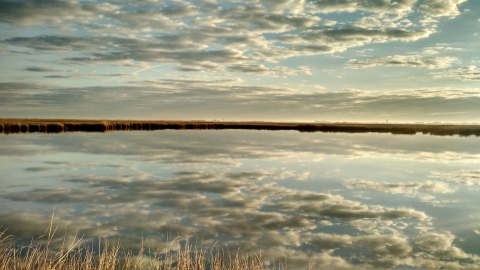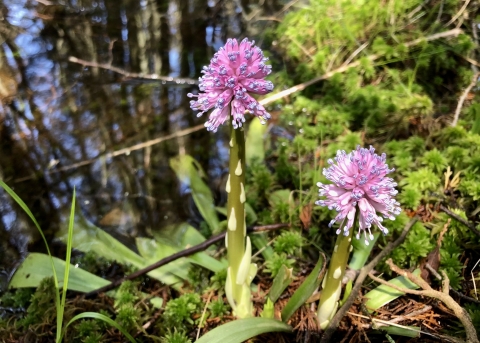What We Do
Wildlife conservation is at the heart of the National Wildlife Refuge System. It drives everything on U.S. Fish and Wildlife Service lands and waters managed within the Refuge System, from the purposes for which a national wildlife refuge national wildlife refuge
A national wildlife refuge is typically a contiguous area of land and water managed by the U.S. Fish and Wildlife Service for the conservation and, where appropriate, restoration of fish, wildlife and plant resources and their habitats for the benefit of present and future generations of Americans.
Learn more about national wildlife refuge is established to the recreational activities offered to the resource management tools used. Using conservation best practices, the Refuge System manages Service lands and waters to help ensure the survival of native wildlife species.
Management and Conservation
Refuges deploy a host of scientifically sound management tools to address biological challenges.
These tools span active water management to wilderness character monitoring, all aimed at ensuring a balanced conservation approach to benefit both wildlife and people. At this field station our conservation tool box includes:
- Planning – Comprehensive Conservation Plan
- Habitat Restoration: Salt Marsh Restoration
- Climate Resilience
- Compatibility Determinations
- Education & Outreach
- Fire Management
- Invasive Species
- Inventory and Monitoring
- Land Acquisition
- Law Enforcement
- Mapping
- Species Research
- Water Management
- Wilderness Character Monitoring
To help plants and wildlife, refuge staff uses a variety of habitat management techniques to maintain, recover or enhance plant and wildlife values. Refuge staff carefully considers any management techniques and employ them in varying degrees according to the situation.
Water levels are carefully monitored and controlled to foster desired plant growth. Sometimes, sensitive areas are closed to the public so that the land can recover more quickly. Prescribed burning, mowing, experimental bio-control insect releases, and seeding are also some of the techniques used to help native plants recover on national wildlife refuges.
Standardized ground and aerial wildlife surveys and vegetation surveys are conducted on some refuges throughout the year to inventory populations and document habitat use. Units are evaluated by how well they met habitat and wildlife use objectives.
Public involvement and input are important to us and to the planning process, and we hope you will take an active interest in the process, individually and as a community.
In early 2017, the Good Luck Point Pole Removal project was completed after the removal of nearly 500 telephone poles and thus restoring approximately 222 acres of marshland to its original natural habitat.
Trapping occurs on this refuge
Trapping is a wildlife management tool used on some national wildlife refuges. Trapping may be used to protect endangered and threatened species or migratory birds or to control certain wildlife populations. The U.S. Fish and Wildlife Service also views trapping as a legitimate recreational and economic activity when there are harvestable surpluses of fur-bearing mammals. Outside of Alaska, refuges that permit trapping as a recreational use may require trappers to obtain a refuge special use permit. Signs are posted on refuges where trapping occurs. Contact the refuge manager for specific regulations.
Our Services
At this field station we offer the following public services:
- America the Beautiful Passes
- Buy Duck Stamps
- Buy Refuge Hunt Permits
- Education and Outreach
- Grant or Funding Opportunity
- Habitat Planning & Management
- Photo Contests
- Recreation
- Special Use Permits - Scientific Research
- Special Use Permits - Commercial Guiding
- Special Use Permits - Commercial Photography
Our Projects and Research
The work that we conduct at the refuge focuses on understanding the needs of endangered species; developing strategies to combat climate change climate change
Climate change includes both global warming driven by human-induced emissions of greenhouse gases and the resulting large-scale shifts in weather patterns. Though there have been previous periods of climatic change, since the mid-20th century humans have had an unprecedented impact on Earth's climate system and caused change on a global scale.
Learn more about climate change impacts to habitat such as sea level rise; and habitat management for a variety of species, but primarily migratory birds.
Coastal Resilience
The majority of the refuge’s 48,000 acres is comprised of salt marshes, beaches and dunes that are vulnerable to storms and sea level rise. We are working to improve the condition of these coastal habitats so that they have the best chance of persisting into the future. This effort entails focused monitoring that helps improve our understanding of the factors contributing to habitat degradation so that we can develop targeted strategies to address it. In many cases the refuge’s coastal habitats are adjacent to neighborhoods and other development that benefit from the shelter provided by salt marshes and beaches. Among recent projects, the refuge used dredge material to restore marshes impacted by ditching and tidal restriction and has augmented beaches to help slow the rate of shoreline erosion.
Endangered Species Monitoring
Endangered species are a key emphasis of our monitoring program, particularly where refuge habitats serve a key role a species’ life cycle. For example, both piping plover and red knot depend on the refuge’s barrier islands of Holgate and Little Beach. These Federally-designated wilderness areas are part of a vast area of undeveloped beaches, dunes, saltmarsh and tidal flats that serve as a true refuge for numerous plant and animal species that are dependent on coastal habitats along a coastline where human development otherwise predominates. A robust monitoring and management program focused on piping plover and other coastal birds helps ensure that the refuge continues to offer these species high-quality habitat along the coast of New Jersey.
Horseshoe Island Monitoring
In 2021, hundreds of birds associated with beach habitat started substantially using a newly formed island off of Little Egg Inlet. The refuge is working with NJDEP and partners to monitor these birds. The NJ Tidelands Council permits closure to the public March 1 through September 30 until 2026 to better understand this dynamic environment. For more information see the Management Plan.
Wildlife Research & Surveys
We monitor the populations and distribution of key species of conservation concern that use refuge habitats, including swamp pink, sea-beach amaranth, piping plover, red knot, black rail, saltmarsh sparrow, American black duck. Our work contributes to broader efforts to track population trajectories and helps inform our efforts to maintain and improve habitat for these species. In addition to our own monitoring efforts, we facilitate and support the work of partners who access the refuge to conduct research and monitoring that supports our collective conservation efforts.
Law Enforcement
The Refuge is patrolled by a United States Fish & Wildlife Law Enforcement Officer. The officer’s office is at the Refuge’s headquarters. Visitors are advised to not approach or challenge individuals observed in alleged illegal activities or wildlife crimes. Please call in a report using the telephone numbers listed below.
- Edwin B. Forsythe National Wildlife Refuge: 609-652-1665, Ext: 7101
- NJ DEP Environmental Hotline: 877-WARNDEP (927-6337)
Laws and Regulations
In order to protect the integrity of the Refuge, there are certain rules and regulations that must be adhered to when visiting. There are multiple uses of the Refuge. They include, but not limited to, activities such as hiking, bird watching, hunting, fishing and photography. Some activities may require permits.
Special Use Permits
Special Use Permits are required for most unusual activities on Edwin B. Forsythe National Wildlife Refuge, including any commercial uses. If you would like to conduct an unusual activity on the Refuge, please call 609-652-1665 and ask to speak to the refuge manger to determine whether you will need a Special Use Permit.
Hunt Permits
An Annual Refuge Hunting Permit is required to hunt on the refuge (see all rates below). We offer deer, migratory bird, squirrel and spring turkey hunting. One Annual Refuge Hunting Permit allows you to hunt all seasons.
You can also download a step-by-step guide detailing how to obtain an Annual Refuge Hunting Permit by clicking here.



